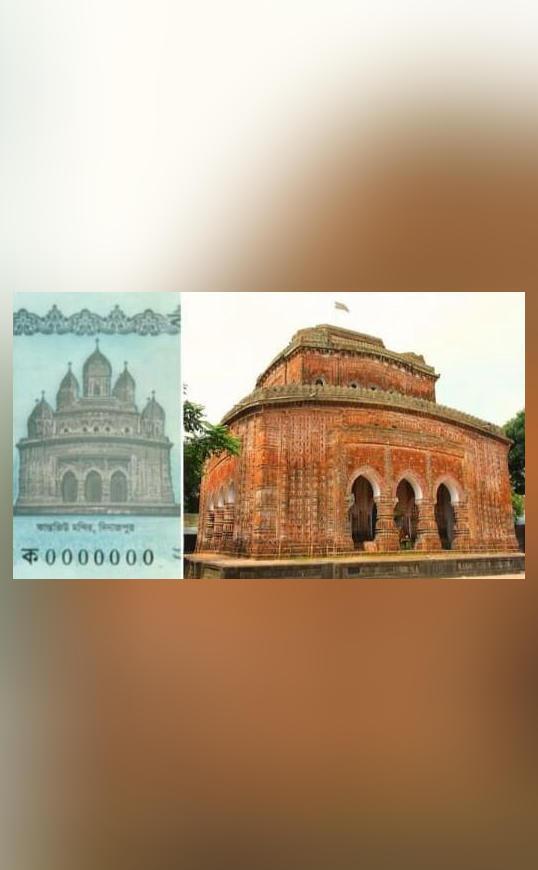
Hindu Temple Attacked by Terrorists Features on New Bangladesh Banknotes
In a significant move towards promoting religious harmony and inclusivity, the Bangladeshi government has featured a Hindu temple that was attacked by terrorists in 2015 on the new 20 taka banknotes. The Kantajew Temple, located in Dinajpur, has taken the place of the portrait of Founding Father Sheikh Mujibur Rahman, who was the country’s first president.
According to information available on the website of Bangla Bank, the new banknotes’ obverse features a picture of the Kantajew Temple. This move is seen as a step towards recognizing the importance of religious diversity and promoting a sense of unity among the country’s diverse population.
The Kantajew Temple, also known as Kantaji’s Temple, is a 17th-century Hindu temple that was attacked by terrorists on June 14, 2015. The temple was set on fire, and several idols were vandalized during the attack. The incident sparked widespread outrage and condemnation across the country, with many calling for greater protection of religious sites and minorities.
The decision to feature the Kantajew Temple on the new banknotes is seen as a positive step towards promoting religious harmony and reconciliation. It is a symbol of the country’s commitment to protecting the rights of all its citizens, regardless of their religious beliefs.
The new banknotes, which were introduced recently, have replaced the portrait of Sheikh Mujibur Rahman, who is revered as the Father of the Nation. Rahman was a key figure in Bangladesh’s struggle for independence from Pakistan and played a significant role in shaping the country’s politics and economy.
The decision to replace his portrait with the Kantajew Temple has been welcomed by many, who see it as a step towards promoting greater religious tolerance and inclusivity. The move is also seen as a recognition of the importance of Hinduism in Bangladesh’s cultural heritage.
The Kantajew Temple is one of the most important Hindu temples in Bangladesh, and its inclusion on the banknotes is a symbol of the country’s commitment to preserving its cultural diversity. The temple is a testament to the rich cultural heritage of Bangladesh and is an important part of the country’s history and identity.
The temple’s inclusion on the banknotes is also seen as a way to promote greater understanding and respect between different religious communities. It is a symbol of the country’s commitment to promoting religious harmony and tolerance, and it sends a powerful message to the world about the importance of protecting religious diversity.
In recent years, Bangladesh has faced several challenges related to religious extremism and intolerance. The country has been plagued by attacks on religious minorities, including Hindus, Christians, and Buddhists, and there have been concerns about the rise of extremist groups.
However, the decision to feature the Kantajew Temple on the banknotes is seen as a positive step towards promoting greater religious tolerance and inclusivity. It is a symbol of the country’s commitment to protecting the rights of all its citizens, regardless of their religious beliefs, and it sends a powerful message to the world about the importance of promoting religious harmony.
The new banknotes are expected to play an important role in promoting greater understanding and respect between different religious communities in Bangladesh. They are a symbol of the country’s commitment to promoting religious harmony and tolerance, and they are expected to have a positive impact on the country’s social and cultural landscape.
In conclusion, the decision to feature the Kantajew Temple, which was attacked by terrorists in 2015, on the new 20 taka banknotes in Bangladesh is a significant move towards promoting religious harmony and inclusivity. It is a symbol of the country’s commitment to protecting the rights of all its citizens, regardless of their religious beliefs, and it sends a powerful message to the world about the importance of promoting religious harmony.
The move is also seen as a recognition of the importance of Hinduism in Bangladesh’s cultural heritage and a testament to the rich cultural diversity of the country. It is a positive step towards promoting greater understanding and respect between different religious communities, and it is expected to have a positive impact on the country’s social and cultural landscape.






